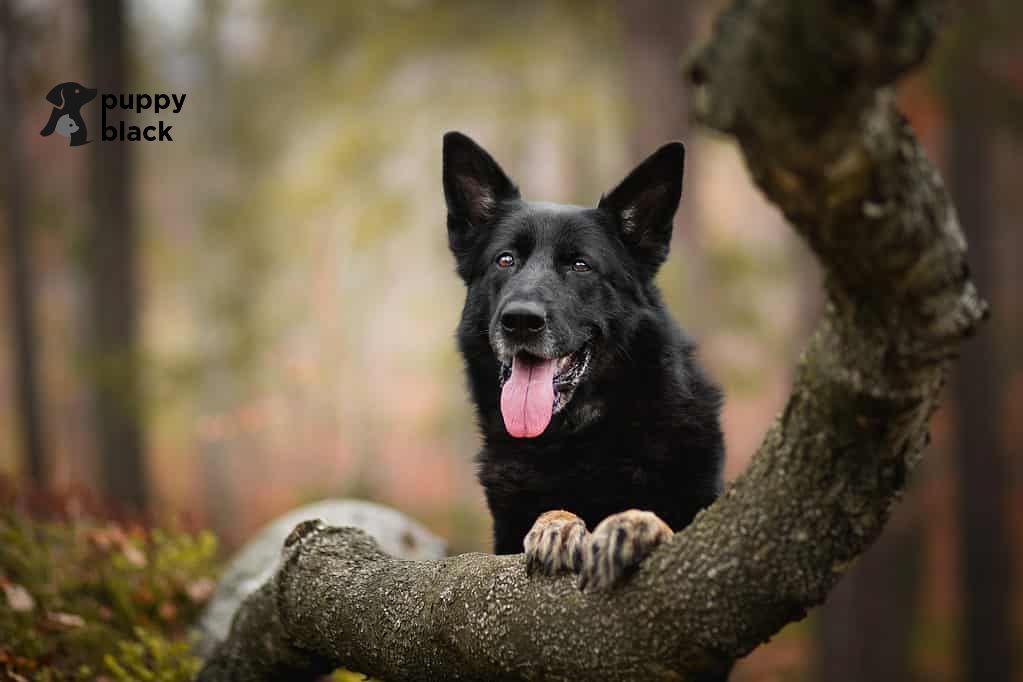The Allure of the Black German Shepherd

Rare Beauty: Transition to focusing specifically on the black German Shepherd. Emphasize the rarity and uniqueness of this color variant, which sets them apart from the more common tan-and-black or sable German Shepherds.
Genetics Behind the Color: Briefly touch on the genetic factors that result in the black coat. Explain that it’s more than just a color difference; it represents a unique genetic makeup within the breed.
Perception and Popularity: Explore how the striking appearance of black German Shepherds influences public perception, perhaps touching on their portrayal in media and their growing popularity among dog enthusiasts.
Celebrating the Black German Shepherd’s Uniqueness
Beyond the Color: Encourage readers to appreciate black German Shepherds for more than their coat color. Highlight that, like all German Shepherds, they possess the breed’s characteristic intelligence, loyalty, and capability.
A Symbol of Diversity within the Breed: Conclude this section by reflecting on how the black German Shepherd stands as a testament to the breed’s diverse genetic heritage, showcasing the beauty and variety within this esteemed canine family.
A Journey into the Rarity of Black German Shepherds
Exploring Uncommon Traits: The article will begin by delving into the rarity of the black German Shepherd. Readers will gain insights into why this particular color variant is less commonly seen compared to other colors in the breed.
Genetic Fascination: We’ll explore the genetics behind the black coat, shedding light on how this unique coloration occurs and what it means for the breed as a whole.
The Financial Aspect: Understanding Pricing
Comparative Analysis: A key focus will be on the pricing of black and brown German Shepherds. This section will provide a comprehensive view of factors that influence the cost of these dogs, including pedigree, breeder reputation, and geographical location.
Practical Advice for Potential Owners: Readers will also receive valuable tips on what to consider financially when looking to adopt or purchase a German Shepherd puppy.
Growth and Development: The Black German Shepherd’s Path
A Closer Look at Physical Growth: The article will cover the growth patterns specific to black German Shepherds, offering insights into their physical development from puppyhood to adulthood.
Health and Care Considerations: In addition to physical growth, there will be a focus on the health and care necessary to ensure these dogs grow up healthy and happy.
The White German Shepherd: A Colorful Counterpart
Introducing Another Variant: We’ll also introduce readers to the white German Shepherd, discussing the genetics behind this equally rare color variant.
Contrasts and Comparisons: This section will compare the white and black variants in terms of health, temperament, and care needs, providing a holistic view of the breed’s diversity.
Wrapping Up: Embracing the Diversity of the Breed
Summary of Key Points: The conclusion will tie together the major themes and insights presented throughout the article, emphasizing the beauty and uniqueness of black German Shepherd puppies.
Encouraging Informed Decisions: The final notes will encourage potential owners to make informed decisions based on the information provided, ensuring the best possible outcomes for both the dogs and their human companions.
The Unique Tapestry of Black German Shepherds
Understanding Black Coloration in German Shepherds
The Science of Color: Begin by explaining the basic genetic principles that determine coat color in dogs. Focus on how specific genes are responsible for the coloration of a German Shepherd’s fur.
The Role of Genetics in Black Coats: Dive deeper into the specific genetic combinations that result in a black coat. Discuss the recessive nature of the gene responsible for the black coloration, which makes it less common compared to dominant genes for other colors.
Beyond Just Black and White: Clarify that the black coat in German Shepherds is not just a simple matter of pigmentation but involves a complex interplay of genetic factors. This complexity contributes to the rarity of this coat color.
The Rarity of Black German Shepherds: A Closer Look
Comparative Rarity: Provide a comparison of the frequency of black German Shepherds with other color variants like tan-and-black, sable, or even white. Utilize statistics or expert opinions, if available, to illustrate the relative scarcity of the black coat.
Breeding Dynamics: Discuss how breeding practices influence the prevalence of black German Shepherds. Since the black color is recessive, it appears less frequently in litters unless both parents carry the gene.
Public Perception and Demand: Explore how the rarity of black German Shepherds affects their desirability and perception among dog enthusiasts and potential owners. Sometimes, rarity can enhance appeal, leading to a unique status within the dog community.
Celebrating the Distinctiveness of Black German Shepherds
Beyond Rarity: Encourage readers to appreciate black German Shepherds for more than their rarity. Highlight their personality, temperament, and capabilities, which are in line with the esteemed qualities of the German Shepherd breed.
A Symbol of Genetic Diversity: Conclude this section by reflecting on how the black German Shepherd represents the diverse genetic potential within the breed. Emphasize that each color variant, including the rare black coat, adds to the rich tapestry that makes the German Shepherd breed so beloved and respected.
The Growth Stages of German Shepherd Puppies
Early Days: Neonatal to Socialization Period (0-3 Months): Begin by outlining the earliest stages of a German Shepherd puppy’s life. Describe how these initial weeks are crucial for physical development and sensory exploration. Highlight the importance of early social interactions in this phase.
Rapid Growth: Juvenile to Adolescence Period (3-6 Months): Discuss the rapid physical growth experienced during this stage. Explain how puppies in this age range start showing more of their personality and require consistent training and socialization.
Maturing Phase: Adolescence to Adulthood (6-18 Months): Delve into the later stages of puppyhood, where growth rates start to slow down, and the focus shifts to strengthening training and reinforcing behaviors. Note the approximate age when German Shepherds reach physical maturity.
Unique Growth Considerations for Black German Shepherds
Coat Development and Care: Address how the black coat of these German Shepherds might require specific care, especially in maintaining its luster and health. Discuss potential differences in coat texture or density compared to other color variants.
Monitoring for Specific Health Issues: While black German Shepherds generally have the same growth patterns as their counterparts, it’s essential to be vigilant for any health issues that might be more prevalent in this color variant, such as skin sensitivities or allergies.
Essential Health and Care Tips for Optimal Development
Nutritional Needs: Emphasize the importance of a balanced diet tailored to the growth needs of German Shepherd puppies. Highlight the role of specific nutrients in supporting bone, joint, and muscle development, crucial for large breeds like German Shepherds.
Exercise and Training: Discuss the balance between exercise and rest. Explain that while exercise is essential for healthy growth, over-exercising a growing puppy can be detrimental to their developing joints.
Regular Health Checkups: Stress the importance of regular veterinary checkups to monitor growth and prevent or address any health issues early on. Include tips on vaccinations, parasite control, and other preventive care measures.
